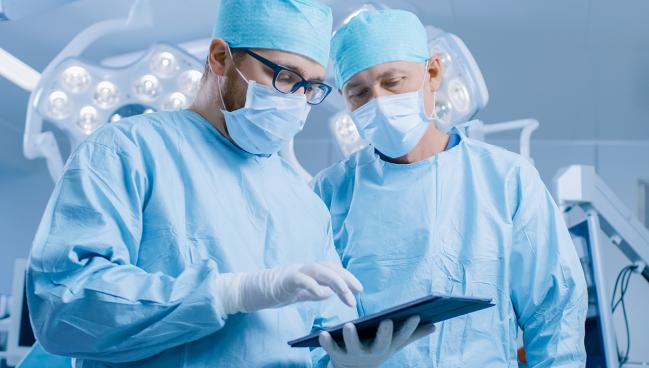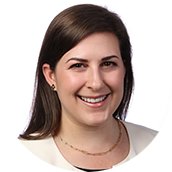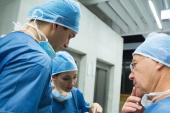Surgeons: Be Active in Tricuspid Procedures or Be ‘Left Behind’
With growth in percutaneous fixes for the valve, surgeons at STS 2025 called for innovation, team-based care, and more data.

LOS ANGELES, CA—With growing numbers of patients now being treated percutaneously for tricuspid valve regurgitation, surgeons are urging their colleagues to be more actively involved in this space or risk being cut out entirely.
That involvement means combatting the narrative that the percutaneous approach is the only option for those with tricuspid valve disease, experts asserted at the recent 2025 Society of Thoracic Surgeons (STS) Annual Meeting.
“Most of us, in our heart team sessions, we keep listening to the cardiologists saying that, ‘Oh, you cannot do a tricuspid valve [surgery] because there’s a very high mortality,’” said Rafael Sadaba, MD, PhD (Hospital Universitario de Navarra, Pamplona, Spain), who co-chaired an STS session on tricuspid valve disease. “This is a myth. We have to destroy this myth, and we have to show everyone that we can do good operations on the tricuspid valve for our patients.”
“Surgery has improving outcomes—we've seen that,” added Vinod H. Thourani, MD (Piedmont Heart Institute, Atlanta, GA), whose presentation at STS reviewed existing data. “It can be done with excellent results, but, quite honestly, . . . very little innovation has occurred.” Some cardiologists may believe that surgeons aren’t needed, but they need to continue to “show up” and prove that “we are better if we work together as a heart team,” he said.
“We've got to find a better pathway to be involved,” Thourani continued. “If we don't, I promise you, . . . we will get left behind.”
Joseph Bavaria, MD (Jefferson Health, Philadelphia, PA), who co-chaired the session, said that while in the past the tricuspid was nicknamed the “forgotten” valve, today it’s better described as “misunderstood,” mostly because data have been lacking. He told TCTMD that surgeons should be active participants in the tricuspid field as they “add to the to the workup and evaluation of patients for the procedure really in a big way.”
Last year, the US Food and Drug Administration approved two transcatheter devices for use in patients with symptomatic tricuspid regurgitation—TriClip (Abbott) and Evoque (Edwards Lifesciences).
The US Centers for Medicare and Medicaid Services is currently deciding how it will reimburse for transcatheter tricuspid valve replacement, with several societies joining forces to push forward a National Coverage Determination similar in scope to that of TAVI, which requires a heart team approach.
Looking at Isolated Operations
During the STS deep dive, Ayesha Ng, MPH (David Geffen School of Medicine at UCLA, Los Angeles, CA), shared new data from the National Inpatient Sample (NIS) on the rate of major adverse events following tricuspid valve surgeries in adults between 2016 and 2021.
Among 51,940 operations, about half (47.2%) were performed concomitantly with mitral valve surgeries, 19.2% were isolated tricuspid procedures, 19% were done with CABG, and 14.6% were in tandem with aortic valve surgeries.
The volume of isolated tricuspid procedures significantly increased from 1,400 to 1,800 cases throughout the study period (P < 0.001), while the volume of all concomitant operations remained stable. Comparatively, the patients who received isolated tricuspid surgeries were younger, more often female, had fewer comorbidities, and were more likely to have a pacemaker or prior valve surgery (P < 0.001 for all).
The highest mortality rates were seen in patients who received concomitant aortic (8.3%) and CABG operations (10.4%). Mortality rates were significantly lower for those undergoing isolated tricuspid (4.7%) or tricuspid-mitral surgeries (3.7%; P < 0.001). Similar patterns were observed for cardiac and respiratory complications, as well as overall major adverse events. The risk of infection was highest for isolated tricuspid surgeries.
Concomitant aortic and CABG operations were also associated with longer hospital lengths of stay, greater costs, and a lower proportion of patients discharged to home (P < 0.001 for all). Notably, tricuspid-mitral surgeries were associated with a 2-day-shorter hospital stay and $10,000 reduction in costs compared with isolated tricuspid operations in adjusted analyses (P < 0.001 for both).
A risk-adjusted trend analysis showed that while the likelihood of major adverse events decreased among the concomitant CABG cohort over time (P = 0.002), this outcome remained unchanged among all other groups, including in those undergoing isolated tricuspid valve surgery.
In the discussion period following the presentation, audience member Gorav Ailawadi, MD (University of Michigan, Ann Arbor), commented that referrals for tricuspid treatments have increased in the United States recently. With transcatheter options now on the table, “I do expect that to change [as] many of the patients now qualify [for percutaneous treatment], even though they may not have qualified for a trial.”
But why, he asked, have the risk-adjusted outcomes not improved for isolated tricuspid surgeries over time? “We're seeing more patients, we're selecting from a potentially larger denominator, and we're learning a lot more about tricuspid disease,” Ailawadi said. “We're doing it more. It's no longer forgotten.”
Ng pointed to the fact that isolated and concomitant tricuspid-mitral procedures “still have the lowest rate of mortality and complications compared to concomitant aortic and CABG operations.” The higher risk of mortality and complications typically associated with isolated tricuspid surgeries are relative to concomitant mitral valve operations, which are much more widely accepted.
While the mortality rate for concomitant tricuspid-mitral valve surgeries was 3.7%, the rate of 4.7% in the isolated cohort is “still fairly low,” she said. The results suggest that while concomitant mitral operation should be encouraged, isolated tricuspid surgery is still a “class 2 recommendation in current guidelines and can be beneficial for these patients with severe tricuspid disease and should be encouraged for patients when appropriate as well,” said Ng.
Surgery Still Has a Place
During his presentation, Thourani said surgical volumes are increasing due to the rise in the numbers of patients referred for percutaneous repair or replacement. Still, while the prevalence of moderate or severe tricuspid regurgitation is high, “very few of them get tricuspid valve surgery—less than 10,000 are done in the United States,” he said.
In under a year, Thourani said, about 1,000 TriClip and 1,500 Evoque cases have been reported. And this is only the beginning, with several more devices coming down the pipeline including Pascal (Edwards Lifesciences), TriFlo, and Trisol.
Michael E. Bowdish, MD (Smidt Heart Institute, Cedars-Sinai Medical Center, Los Angeles, CA), encouraged the room that the tricuspid valve has “not been forgotten” by the STS. In his presentation, he urged surgeons to use the new calculator that was released last year for this disease pathway.
“Isolated tricuspid surgery is not rare,” he said. “And this STS calculator is a very useful tool. Our intent is for this to inform clinical decision making, especially when patients sit down with their surgeons or physicians . . . because we really would like people to have something useful to try to predict what peoples’ operative risk is.”
Importantly, Ailawadi commented, when looking at his institution’s tricuspid referrals over the last 4 years, “about 40 to 50% were essentially determined to be cohort C,” a category referring to the sickest group of patients who might not benefit from intervention. “They're not presenting to us with an STS risk of 2 or 3%; they're usually 80, frail, and have had maybe surgery before,” he said, and many might not have previously qualified for a transcatheter procedure.
This is likely to change, according to Ailawadi. “I think in 5 years we're going to see even less surgical cases,” he said. “We're going to see the failures that have to be operated on. They're going to be very difficult.”
Yael L. Maxwell is Senior Medical Journalist for TCTMD and Section Editor of TCTMD's Fellows Forum. She served as the inaugural…
Read Full BioSources
Ng A. Trends in utilization and outcomes of isolated and concomitant tricuspid valve surgery in the United States. Presented at: STS 2025. January 24, 2025. Los Angeles, CA.
Thourani VH. Recent tricuspid transcatheter valve trials and what they mean for surgeons. Presented at: STS 2025. January 24, 2025. Los Angeles, CA.
Disclosures
- Ng reports no relevant conflicts of interest.
- Bavaria reports serving on the DSMB for Abbott/St. Jude Medical; receiving research grants from Abbott/St. Jude Medical, Artivion, Corcym, Edwards Lifesciences, Terumo Aortic, and W.L. Gore & Associates; serving as a consultant for Baxter, Edwards Lifesciences, and W.L. Gore & Associates; serving on the board of directors for Peca Lab; and serving as a speaker for Terumo Aortic.
- Thourani reports serving as an advisor to and conducting research funded by Abbott Vascular; serving as an advisor to and on a steering committee for Artivion; serving as an advisor to Atricure; serving as an advisor to and on a steering committee for Boston Scientific; serving as a national PI for a trial funded by Croivalve; serving as an advisor to and holding equity in Dasi Simulation; serving as a co-PI for trials funded by JenaValve; receiving research grants from Laplace; serving as an advisor to, on steering and advisory committees for, and conducting research funded by Edwards Lifesciences; receiving research grants from Medtronic; receiving research grants from and holding equity in Pi-Cardia; conducting research for TRICARES; and conducting research for and holding equity in Trisol.





Comments